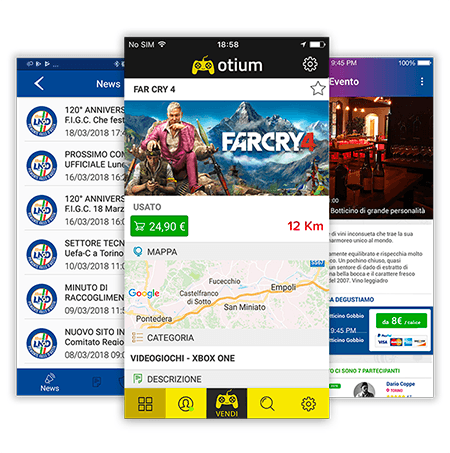- 21 March 2024
- Posted by: Maria Teresa Italiano
- Category: News
Web development trends in 2024: what to expect
2024 is shaping up to be a year of significant technological innovations, with profound impacts on how web agencies design, develop and optimize websites. In this article, we explore the most significant trends in web development that will define the technology landscape in this year.
Disclaimer: Although we are already in March 2024, the web development trends discussed here fully retain their validity and relevance. The web industry is notoriously fast-paced and ever-changing; however, the innovations and directions indicated represent solid foundations upon which web agencies and developers will continue to build and innovate throughout the year.
Massive Adoption of AI and Machine Learning
Artificial intelligence (AI) and machine learning continue to revolutionize the web development industry. In 2024, we expect even more massive adoption of these technologies, with AI able to personalize user experience in real time, optimize website performance, and offer valuable insights through data analysis.
We are seeing a growing adoption of AI-driven chatbots, personalized recommendation systems and predictive analytics tools, which significantly improve user engagement and operational efficiency. AI-driven chatbots are powered by advanced machine learning and natural language processing (NLP) technologies, enabling them to understand and respond to user requests in a more natural and contextualized way. These chatbots are designed to continuously learn from previous interactions, improving their ability to provide relevant responses and real-time assistance. The implementation of chatbots in websites and applications is done through the integration of artificial intelligence APIs and the use of specialized chatbot development platforms.
Progressive Web Apps (PWA) take center stage
Progressive Web Apps continue to gain ground, due to their ability to offer a user experience comparable to native apps with the flexibility of the Web. PWAs in 2024 benefit from significant advances in web technologies, such as intelligent caching and early loading strategies, which greatly improve loading times and overall performance.
One of the most exciting innovations for PWAs is their increasingly deep integration with smartphone, tablet and desktop operating systems. PWAs can now be installed directly on the user’s device, offering a quick start icon and a full-screen experience that mimics that of a native app.
Finally, PWAs have access to a broader set of hardware features and operating system APIs, such as push notifications, camera access, geolocation, and more, expanding the possibilities of what they can do.
Enhanced web security
As cyber threats increase, web security becomes a top priority. In 2024, we are seeing an increased emphasis on security at every level of web development, from the implementation of HTTPS as a standard to the adoption of more stringent security policies.
Web Application Firewalls (WAFs) have become more advanced, providing a protective barrier between the Web site and Internet traffic. A modern WAF can automatically identify and block common attack attempts, such as SQL injection and cross-site scripting (XSS), relying on predefined rules and machine learning to adapt to new threats. When incoming traffic matches these patterns, it is blocked or logged for further analysis, thus preventing exposure of web application vulnerabilities.
‘Multi-factor authentication has also become a de facto standard for accessing online accounts, requiring users to verify their identity through multiple methods before granting access. This approach significantly reduces the risk of unauthorized access, even if login credentials are compromised.
Web sites increasingly accessible
Accessibility and inclusiveness are confirmed as fundamental pillars of web development, reflecting the digital community’s commitment to making the web accessible to all, regardless of disabilities or limitations. This not only improves the user experience for a wider audience but is also a legal requirement in many countries.
Assistive technologies, such as screen readers, adaptive keyboards and speech recognition software, play a key role in Web accessibility. The development of these technologies has made great strides, with significant improvements in the accuracy of speech recognition and the effectiveness of screen readers.
WAI-ARIA, which stands for Web Accessibility Initiative – Accessible Rich Internet Applications, is the ‘set of technical specifications developed by the World Wide Web Consortium (W3C). Its main purpose is to improve accessibility and make web content and applications more accessible to people with disabilities. Through the use of special attributes embedded in HTML code, ARIA improves the accessibility of dynamic Web applications by enabling screen readers and other assistive technologies to interpret and interact with complex Web content.
Cutting-edge web development technologies
Finally, 2024 sees the emergenceof new web development technologies, such as the Vue 3 JavaScript framework, the Vite build tool, and the Rust programming language for WebAssembly applications.
Vue.js, already known for its ease of use and flexibility as a front-end framework, takes the concept of responsiveness and composability to a new level with version 3. Vue 3 introduces the Composition API as an alternative to the Options API, allowing developers to better organize code and reuse logic between components. With improved TypeScript support and Proxy-based responsiveness system, Vue 3 makes the development of rich, high-performance user interfaces more accessible and maintainable.
ViteJS emerges as a state-of-the-art build tool designed to maximize efficiency. Using advanced caching techniques and automatic optimizations, it significantly reduces compile time and improves development performance. It supports a wide range of frameworks and library, making it a versatile choice for web projects of all sizes and complexities.
Rust is confirmed as the programming language of choice for WebAssembly development because of its emphasis on memory safety and performance. With Rust, developers can create high-performance code to run in the browser, opening up new possibilities for Web applications that require intensive computation or the manipulation of large amounts of data in real time. The combination of Rust and WebAssembly represents a powerful tool for overcoming the traditional limitations of web applications, making it possible to develop games, image editors, simulations, and other compute-intensive applications directly in the browser


